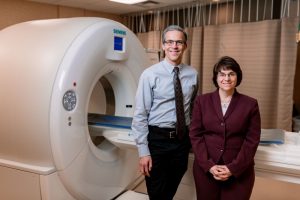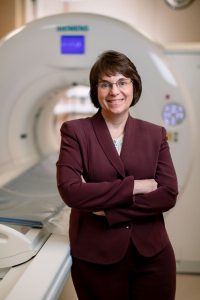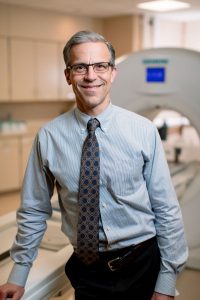CT Clinical Innovation Center: four decades of CT innovation at Mayo Clinic
Mayo Clinic, in its CT Clinical Innovation Center, is the first medical center in the world to image patients with a novel CT scanner equipped with a photon-counting detector. Unlike current clinical CT scanners, the detector on the new system is fast enough to count individual X-rays as they interact with the solid-state detector material. Advantages of the new technology, which is still in the research and development phase, include better spatial and contrast resolution, more quantitative information and lower radiation doses.
The system was placed at Mayo Clinic in 2014 as part of a Bioengineering Research Partnership award from the National Institutes of Health. The industry partner for the award, Siemens Healthcare, has been developing the technology for more than a decade. The research system at Mayo will help Siemens translate the technology advances into patient care.
“This scanner is a research device, and the detectors were custom made,” says Cynthia McCollough, Ph.D. (R-D ’91), Division of Medical Physics, Department of Radiology at Mayo Clinic in Rochester, and co-director of Mayo’s CT Clinical Innovation Center. “Commercialization of the technology is at least five years away.
“We are using the scanner to look at very early stages of coronary artery disease. We want to identify thickening of vessel walls before it impedes blood flow. Specifically, we are measuring contrast enhancement in the tiny microvessels of the walls of the coronary arteries, namely the vasa vasorum. Early in the disease process, new vasa vasorum form. But because these new vessels are ‘leaky,’ we can see slight signals in the walls after the injection of iodinated contrast material. We wouldn’t be able to see that with a traditional CT scanner. Our hope is to identify and treat atherosclerotic changes before a plaque or stenosis forms.”
Dr. McCollough and her colleagues also are using the scanner to see finer detail in body regions including the bones, abdomen and lungs.
“CT innovation is a part of our clinical practice, so patients may get access to types of imaging not available elsewhere,” says Dr. McCollough. “Mayo has more than 20 CT scanners on the Rochester campus alone and performs more than 500 CT scans per day.”
Looking back
The CT practice at Mayo Clinic is known for innovation. Mayo had the first CT scanner in North America in 1973. Mayo’s radiologists were pioneers in learning to interpret CT images and founding members of the professional societies that advanced the field.
In the 1980s Mayo Clinic installed the first of several electron-beam CT scanners. These unique scanners were fast enough to scan a beating heart, making Mayo among the first to scan coronary arteries. Mayo was a leading research site in quantification of coronary artery calcification to independently assess the risk of a heart attack. These scanners were the first to allow imaging of an entire organ in a single breath-hold, which led to the development of a CT exam for the detection of pulmonary emboli.
In 1998 Mayo installed one of the first multi-slice CT scanners. These systems simultaneously acquired data from multiple positions and greatly increased the scan speed compared to conventional scanners of that era, eventually replacing the electron-beam CT technology. Mayo was at the forefront of this technological change, publishing some of the first studies on the technical and clinical performance of these scanners.
In 2004 the CT Clinical Innovation Center opened to formally integrate this pattern of innovation with Mayo’s busy clinical practice. The center is co-directed by Joel Fletcher, M.D. (R-GI ’98), Division of Abdominal Imaging, Department of Radiology. Within a year, the Mayo team helped to develop and demonstrate the value of CT enterography in identifying treatable causes of intestinal bleeding.
In 2006 Mayo introduced dual-energy CT scanning, which differentiates material such as bone and iodinated blood vessels, allowing for rapid identification of vascular anatomy. Dual-energy CT also is used to identify material composition and has enabled new CT clinical applications, including the identification of gout, uric acid kidneys tones and leaking silicone from breast implants. It can further differentiate retained contrast material from hemorrhage in stroke patients.
Mayo Clinic is a leader in low-dose CT imaging and has developed multiple technologies independently and in conjunction with industry partners. These technologies have been adopted around the world and can reduce radiation dose without compromising image quality. Mayo Clinic also has developed ways to optimize CT scanning. This involves techniques to minimize radiation exposure to the patient without compromising image quality. Similarly, Mayo developed ways to scan patients using less of the iodinated contrast material that may be contraindicated in patients with poor kidney function. The techniques Mayo developed allows patients who otherwise could not be scanned to have CT scans safely.
Moving CT technology and clinical practice forward
At the December 2016 Radiological Society of North America’s Scientific Assembly and Annual Meeting in Chicago, Illinois, physicians and researchers from Mayo’s CT Clinical Innovation Center contributed 37 presentations.
“This is one of the biggest medical society meetings in the world, attracting about 60,000 people,” says Dr. McCollough. “A researcher or team might submit one or two abstracts to such a meeting. We submitted 50, and 37 were chosen for presentation. We have a high acceptance rate for our abstracts because of our high-quality work. Our peers say, ‘Is there anything you guys are not working on?’”
Dr. McCollough says the CT Clinical Innovation Center allows Mayo to remain at the cutting edge because it provides an ecosystem that fosters new ideas. “A radiologist who has an interesting idea but no funding for a study can come to us for resources to complete a project, write papers and make presentations about it. We have the radiologists, physicists, technologists, computer scientists and nurses necessary to continue our legacy of CT innovation. It’s the mission of the center to bring together all the players necessary to move CT technology and clinical practice forward.”


